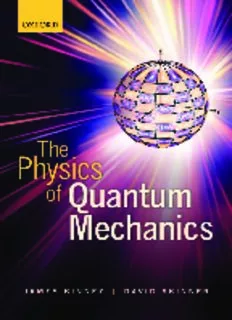Table Of ContentTHE PHYSICS OF QUANTUM MECHANICS
The Physics of Quantum Mechanics
JAMES BINNEY
RudolfPeierlsCentreforTheoreticalPhysicsandMertonCollege,
UniversityofOxford
DAVID SKINNER
DepartmentofAppliedMathematicsandTheoreticalPhysics,
UniversityofCambridge
3
3
GreatClarendonStreet,Oxford,OX26DP,
UnitedKingdom
OxfordUniversityPressisadepartmentoftheUniversityofOxford.
ItfurtherstheUniversity’sobjectiveofexcellenceinresearch,scholarship,
andeducationbypublishingworldwide.Oxfordisaregisteredtrademarkof
OxfordUniversityPressintheUKandincertainothercountries
(cid:2)c JamesBinneyandDavidSkinner2014
FirstpublishedbyCappellaArchivein2008
Themoralrightsoftheauthorshavebeenasserted
FirstEditionpublishedin2014
Impression:1
Allrightsreserved.Nopartofthispublicationmaybereproduced,storedin
aretrievalsystem,ortransmitted,inanyformorbyanymeans,withoutthe
priorpermissioninwritingofOxfordUniversityPress,orasexpresslypermitted
bylaw,bylicenceorundertermsagreedwiththeappropriatereprographics
rightsorganization.Enquiriesconcerningreproductionoutsidethescopeofthe
aboveshouldbesenttotheRightsDepartment,OxfordUniversityPress,atthe
addressabove
Youmustnotcirculatethisworkinanyotherform
andyoumustimposethissameconditiononanyacquirer
PublishedintheUnitedStatesofAmericabyOxfordUniversityPress
198MadisonAvenue,NewYork,NY10016,UnitedStatesofAmerica
BritishLibraryCataloguinginPublicationData
Dataavailable
LibraryofCongressControlNumber:2013940021
ISBN978–0–19–968856–2(hbk.)
ISBN978–0–19–968857–9(pbk.)
Printedandboundby
CPIGroup(UK)Ltd,Croydon,CR04YY
This book is a consequence of the vision and munificence of
Walter of Merton, who in 1264 launched something good
Contents
Preface xii
1 Introduction 1
1.1 Origins 2
1.2 Measurements 6
• Measurement involves disturbance 7
⊲ Heisenberg microscope 7 • Ideal measurements 8
• Summary 10
1.3 Probability amplitudes 11
• Two-slit interference 12
1.4 Quantum states 14
• Observables 14 ⊲ Complete sets of amplitudes 14
• Vector spaces and their duals 16 • The energy represen-
tation 19 • Polarisation of photons 20
1.5 Summary 23
Problems 24
2 Operators, measurement and time evolution 25
2.1 Operators 25
⊲ Functions of operators 29 ⊲ Commutators 29
2.2 Evolution in time 31
• Evolution of expectation values 32
2.3 The position representation 34
• Hamiltonian of a particle 37 • Wavefunction for well-
defined momentum 38 ⊲ The uncertainty principle 39
• Dynamics of a free particle 41 • Back to two-slit in-
terference 43 • Generalisation to three dimensions 44
⊲ Probability current 45 ⊲ The virial theorem 46
2.4 Summary 47
Problems 48
viii Contents
3 Oscillators 52
3.1 Stationary states of a harmonic oscillator 52
3.2 Dynamics of oscillators 56
• Anharmonic oscillators 58
Problems 61
4 Transformations and observables 66
4.1 Transforming kets 66
• Translating kets 67 • Continuous transformations and
generators 69 • The rotation operator 71 • Discrete
transformations 72 ⊲ The parity operator 72 ⊲ Mirror
operators 73
4.2 Transformations of operators 74
⊲ The parity operator 76 ⊲ Mirror operators 78
4.3 Symmetries and conservation laws 79
4.4 The Heisenberg picture 81
4.5 What is the essence of quantum mechanics? 83
Problems 85
5 Motion in step potentials 88
5.1 Square potential well 88
• Limiting cases 91 ⊲ Infinitely deep well 91 ⊲ Infinitely
narrow well 92
5.2 A pair of square wells 93
• Ammonia 96 ⊲ The ammonia maser 97
5.3 Scattering of free particles 99
⊲ The scattering cross-section 102 • Tunnelling through
a potential barrier 103 • Scattering by a classically
allowed region 104 • Resonant scattering 106
⊲ The Breit–Wigner cross-section 109
5.4 How applicable are our results? 113
5.5 Summary 115
Problems 117
6 Composite systems 123
6.1 Composite systems 124
• Collapse of the wavefunction 128 • Operators for com-
posite systems 129 • Development of entanglement 131
• Einstein–Podolski–Rosen experiment 132
⊲ Bell’s inequality 134
6.2 Quantum computing 137
Contents ix
6.3 The density operator 144
• Reduced density operators 148 • Shannon entropy 151
6.4 Thermodynamics 154
6.5 Measurement 158
Problems 162
7 Angular momentum 167
2
7.1 Eigenvalues of Jz and J 168
• Rotation spectra of diatomic molecules 171
7.2 Spin and orbital angular momentum 174
• Orbital angular momentum 174 ⊲ L as the generator of
2
circular translations 176 ⊲ Spectra of L and Lz 177
• Spin angular momentum 177
7.3 Physics of spin 180
• Spin-half matrices 181 • Spin-one matrices 182
• The Stern–Gerlach experiment 183 ⊲ Stern–
Gerlach experiment with spin-one atoms 186
• Precession in a magnetic field 187 • The classical
limit 188
7.4 Orbital angular-momentum eigenfunctions 191
• Orbital angular momentum and parity 196 • Orbital
angular momentum and kinetic energy 196 • Legendre
polynomials 198
7.5 Three-dimensional harmonic oscillator 199
7.6 Addition of angular momenta 205
• Case of two spin-half systems 209 • Case of spin-one
and spin-half 211 • The classical limit 212
Problems 213
8 Hydrogen 219
8.1 Gross structure of hydrogen 220
• Emission-line spectra 226 • Radial eigenfunctions 226
• Shielding 231 • Expectation values for r k 234
−
8.2 Fine structure and beyond 236
• Spin–orbit coupling 236 • Hyperfine structure 241
Problems 243
9 Motion in a magnetic field 247
9.1 Hamiltonian for motion in a magnetic field 248
• Classical equations of motion 248
9.2 Gauge transformations 250
• Probability current 251
Description:The Physics of Quantum Mechanics aims to give students a good understanding of how quantum mechanics describes the material world. It shows that the theory follows naturally from the use of probability amplitudes to derive probabilities. It stresses that stationary states are unphysical mathematical

